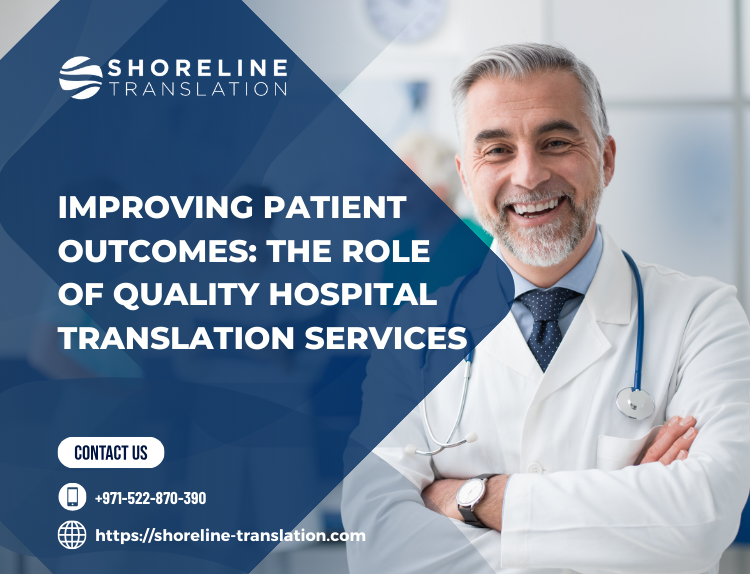Table of Contents
ToggleImproving Patient Outcomes: The Role of Quality Hospital Translation Services
Welcome to the fascinating world of healthcare, where every individual’s well-being is a top priority. In this fast-paced environment, effective communication plays a vital role in ensuring positive patient outcomes. But what happens when language becomes a barrier? That’s where quality hospital translation services come to the rescue!
Imagine being in a foreign country with limited knowledge of the local dialect and suddenly finding yourself in need of medical assistance. It can be an overwhelming and stressful experience for anyone. Fortunately, hospitals are recognizing the importance of breaking down language barriers by providing professional translation services.
In this blog post, we will explore why quality hospital translation services are crucial for improving patient outcomes. We’ll delve into the challenges non-English speaking patients face in healthcare settings and how these language barriers impact their overall care and treatment. Stay tuned as we highlight real-life examples showcasing how effective translation services have transformed lives within medical facilities!
So grab your stethoscope (or notepad) because we’re about to embark on an informative journey that will shed light on the significant role played by quality hospital translation services! Let’s dive right in!

The Importance of Quality Hospital Translation Services
When it comes to providing healthcare services, communication is key. But what happens when a patient doesn’t speak the same language as their healthcare provider? That’s where quality hospital translation services come into play. These services are essential in ensuring that patients receive the care and treatment they need, regardless of their language barrier.
Quality hospital translation services help bridge the gap between non-English speaking patients and healthcare providers. Imagine being in a foreign country, feeling sick or injured, and not being able to effectively communicate your symptoms or understand the instructions given by medical professionals. It can be frustrating and even dangerous. With professional translation services in place, patients can have access to accurate translations of medical terminology, diagnoses, treatment options, and more.
These services enhance patient safety and ensure better health outcomes. Miscommunication due to language barriers can lead to misunderstandings about medications or treatments prescribed by doctors. This can result in medication errors or inappropriate care that could harm patients’ well-being. By having trained interpreters available for effective communication with non-English speaking patients, hospitals can reduce medical errors and improve overall patient safety.
Lastly (for now), quality hospital translation services promote cultural sensitivity and inclusivity in healthcare settings. Language is deeply connected to culture; therefore understanding a patient’s native language helps create an environment where they feel understood and respected for their unique backgrounds. Feeling heard and valued contributes positively to trust-building between patients and healthcare providers – which ultimately leads to improved patient satisfaction levels.
Understanding the Challenges Faced by Non-English Speaking Patients in Healthcare Settings
Picture this: You’re in a hospital, seeking medical care. You’re already feeling vulnerable and anxious. Now imagine that you don’t speak the language of the doctors and nurses who are trying to help you. It’s a frustrating and isolating experience, isn’t it? Unfortunately, this is a reality for many non-English speaking patients in healthcare settings.
Communication is key when it comes to providing quality healthcare, but language barriers can create significant challenges. Non-English-speaking patients struggle to understand their diagnosis, treatment options, and even basic instructions. They may feel confused or misunderstood, leading to increased anxiety and potentially compromising their health outcomes.
The difficulties faced by non-English speaking patients extend beyond simple misunderstandings; they can also result in serious consequences such as medication errors or delays in receiving timely care. Additionally, these individuals may be less likely to seek necessary medical attention due to fear of not being understood or cultural differences that discourage seeking help outside their community.
Understanding the challenges faced by non-English speaking patients is crucial for improving patient outcomes and ensuring quality care for all individuals, regardless of language barriers. By addressing these challenges head-on with effective translation services, hospitals can bridge the communication gap and provide equitable healthcare experiences for everyone who walks through their doors.
The Impact of Language Barriers on Patient Outcomes and Quality of Care
Language barriers can have a profound impact on patient outcomes and the overall quality of care provided in healthcare settings. When patients cannot effectively communicate their symptoms, medical history, or concerns due to language differences, it becomes incredibly challenging for healthcare providers to accurately diagnose and treat them.
Miscommunication caused by language barriers can lead to errors in medication administration or treatment plans. Vital information may be misunderstood or lost in translation, leading to potential adverse reactions or ineffective treatments. This not only jeopardizes the health of non-English speaking patients but also puts additional strain on healthcare resources.
Language barriers hinder effective patient-provider communication and engagement. Patients who do not fully understand their diagnosis or treatment options may feel anxious, confused, or reluctant to ask questions. As a result, they are less likely to adhere to prescribed treatments and follow-up appointments.
Misunderstandings arising from language barriers can contribute to longer hospital stays and increased readmission rates. Without a proper understanding of discharge instructions or post-operative care guidelines, patients are at higher risk for complications that could have been prevented with clear communication.
In conclusion (oops!), addressing these language barriers is crucial for improving patient outcomes and ensuring high-quality care for all patients regardless of their native language proficiency!
Benefits of Utilizing Professional Translation Services in Hospitals
1. Improved communication: By utilizing professional translation services, hospitals can effectively bridge the language gap between healthcare providers and non-English speaking patients. This leads to clear and accurate communication, ensuring that patients fully understand their diagnosis, treatment plans, and medication instructions.
2. Enhanced patient safety: Language barriers in healthcare settings can have serious consequences for patient safety. With professional translation services, hospitals can ensure the accurate transmission of vital information such as medical histories, allergies, and symptoms. This reduces the risk of misunderstandings or errors that could compromise patient safety.
3. Culturally sensitive care: Professional translators are not only fluent in languages but also well-versed in cultural nuances. They understand the importance of providing culturally sensitive care to patients from diverse backgrounds. This helps create a more comfortable environment for patients and promotes trust between them and their healthcare providers.
4. Increased efficiency: Utilizing professional translation services streamlines processes within hospitals by eliminating misunderstandings caused by language barriers. Healthcare providers can focus on delivering quality care rather than struggling with language-related challenges during consultations or documentation.
5. Compliance with regulatory standards: Many countries have laws and regulations requiring healthcare facilities to provide language access services for non-English speaking patients to ensure equal access to healthcare resources. By employing professional translation services, hospitals can comply with these standards while avoiding potential legal issues.
6. Cost-effective solution: While some may view professional translation services as an additional expense, it is a cost-effective solution in the long run compared to hiring full-time interpreters or relying on ad hoc solutions like staff members who speak multiple languages but lack specialized medical terminology knowledge.
7. Improved patient satisfaction: Effective communication through quality hospital translation services leads to enhanced patient satisfaction levels as they feel heard and understood throughout their interactions with healthcare professionals.
Characteristics of a Quality Hospital Translation Service Provider
When it comes to selecting a quality hospital translation service provider, there are certain characteristics that you should look for. First and foremost, expertise is key. A reliable provider will have a team of highly skilled translators who have experience in the medical field. They understand the nuances and terminology specific to healthcare and can accurately translate complex medical information.
Reliability is crucial. You need a provider that you can count on to deliver accurate translations promptly. Look for one that has a track record of meeting deadlines and providing high-quality work consistently.
Another important characteristic is cultural sensitivity. Patients from different backgrounds may have unique beliefs, customs, and perspectives on healthcare. A good translation service provider understands this diversity and ensures that their translations respect cultural norms while maintaining accuracy.
When choosing a hospital translation service provider, prioritize expertise, reliability, and cultural sensitivity to ensure the highest quality translations for your non-English speaking patients’ needs.
Real-life Examples of How Effective Translation Services Have Improved Patient Outcomes
1. Clear Communication Saves Lives:
Imagine a scenario where a non-English speaking patient arrives at the emergency room, unable to communicate their symptoms due to language barriers. In such cases, hospital translation services play a critical role in ensuring accurate understanding and diagnosis. By providing professional interpreters or translators, hospitals can bridge this gap and facilitate effective communication between healthcare providers and patients. This enables doctors to make informed decisions quickly, leading to better treatment outcomes.
2. Enhancing Patient Satisfaction:
Effective translation services not only improve medical outcomes but also enhance patient satisfaction levels. When patients can understand their diagnoses, treatment plans, medication instructions, and follow-up care in their native language, it reduces anxiety and confusion significantly. Patients feel more involved in their healthcare journey and have greater trust in the medical team’s expertise when they can communicate effectively with them.
3. Empowering Cultural Sensitivity:
Quality hospital translation services go beyond mere language interpretation; they also consider cultural nuances that impact healthcare interactions. For instance, certain cultures may have different beliefs about health or traditional remedies that could influence treatment decisions or adherence to medications by patients from those backgrounds. With knowledgeable interpreters who understand these cultural sensitivities along with linguistic proficiency, hospitals can provide personalized care that respects each patient’s unique needs.
Best Practices for Implementing Translation Services in Hospitals
Implementing translation services in hospitals requires careful planning and execution to ensure that non-English-speaking patients receive the best possible care. Here are some best practices to consider:
1. Assess Language Needs: Start by assessing the language needs of your patient population. Determine which languages are most commonly spoken among your patients and prioritize those for translation services.
2. Train Staff: It’s crucial to provide training to hospital staff on how to effectively communicate with non-English speaking patients through interpreters or translated materials. This will help create a more inclusive and empathetic healthcare environment.
3. Utilize Technology: Explore technology solutions, such as remote video interpretation services or mobile apps, that can enhance communication between healthcare providers and non-English speaking patients, especially in urgent situations when an interpreter may not be available onsite.
Remember, implementing translation services is an ongoing process that requires continuous evaluation and improvement. By following these best practices, hospitals can bridge language barriers and provide quality care for all patients, regardless of their native language.
Shoreline Translation Offers Hospital Translation Services
Are you tired of the language barriers that hinder effective communication in hospitals? Look no further because Shoreline Translation is here to save the day! With their top-notch hospital translation services, they are dedicated to improving patient outcomes by bridging the gap between healthcare providers and non-English speaking patients.
Shoreline Translation understands that accurate and timely communication is key when it comes to delivering quality healthcare. Their team of professional translators is not only fluent in multiple languages but also well-versed in medical terminology. This ensures that every message, whether it’s a diagnosis or treatment plan, is accurately conveyed to patients who may otherwise struggle to understand.
But what sets Shoreline Translation apart from other translation service providers? It’s their commitment to excellence and attention to detail. They pride themselves on delivering high-quality translations within tight deadlines, ensuring that critical information reaches patients promptly. Plus, their dedication doesn’t end with just translating documents – they also offer interpretation services for real-time communication during appointments or emergencies.
So why settle for subpar translation services when you can rely on Shoreline Translation’s expertise? Don’t let language barriers compromise patient care any longer. Trust the professionals at Shoreline Translation to provide exceptional hospital translation services that improve patient outcomes and enhance the overall quality of care.
FAQs
1. How can professional translation services improve patient outcomes in hospitals?
Professional translation services play a crucial role in improving patient outcomes in hospitals. By providing accurate and culturally appropriate translations, these services ensure effective communication between healthcare providers and non-English speaking patients. This leads to a better understanding of medical conditions, treatment options, and important instructions, ultimately resulting in improved patient compliance and overall health outcomes.
2. What are the characteristics of a quality hospital translation service provider?
A quality hospital translation service provider should have certified translators with expertise in medical terminology and cultural nuances. They should offer fast turnaround times while maintaining accuracy and confidentiality. Additionally, they should have robust quality assurance processes in place to ensure the highest level of translations.
3. Can you provide real-life examples of how effective translation services have improved patient outcomes?
Absolutely! Effective translation services have been shown to reduce medication errors by ensuring clear instructions on dosage and usage for non-English speaking patients. In emergencies, accurate translations help healthcare providers quickly assess symptoms and provide timely care. Moreover, when language barriers are overcome through professional translations, patients feel more comfortable discussing their health concerns leading to earlier diagnosis and treatment.
Conclusion
In today’s diverse healthcare landscape, quality hospital translation services play a vital role in improving patient outcomes and ensuring that every individual receives the care they deserve. By understanding the challenges faced by non-English speaking patients, hospitals can address language barriers head-on and provide effective communication solutions.
Language barriers should never be underestimated when it comes to their impact on patient outcomes and the overall quality of care provided. Miscommunication due to language differences can lead to medical errors, delayed treatment, decreased patient satisfaction, and even compromised health outcomes. Hospitals need to recognize this issue and take proactive steps toward finding a solution.
By utilizing professional translation services in hospitals, healthcare providers can bridge the gap between different languages and cultures. The benefits are clear – improved accuracy in medical history documentation, enhanced comprehension of diagnosis and treatment plans, increased patient compliance with medication instructions, reduced readmission rates, better patient experiences overall…the list goes on!
When choosing a hospital translation service provider, there are some key characteristics to look out for expertise in medical terminology across different languages; certified translators with industry-specific knowledge; secure handling of confidential information; availability of interpretation services both onsite and remotely; prompt response times; cultural sensitivity training for translators; and a commitment to delivering accurate translations.
Real-life examples demonstrate how effective translation services have positively impacted patient outcomes. From enabling clear communication during emergencies to facilitating informed consent discussions with patients from diverse backgrounds – these success stories highlight the power of effective language support in healthcare settings.
To implement translation services successfully within hospitals, it is important to establish best practices. This includes developing comprehensive language access policies that outline procedures for requesting interpreters or translated materials. Training staff members on cultural competency is also crucial so they can effectively communicate with patients from various backgrounds.
At Shoreline Translation, we understand the importance of providing quality hospital translation services tailored specifically for healthcare organizations. Our team consists of experienced translators who possess extensive knowledge of medical terminology, ensuring accurate and culturally appropriate translations. We offer a range of services such as document translation, interpretation, and transcription to help bridge the communication gap in healthcare settings.
Don’t let language barriers hinder effective healthcare delivery any longer. Contact Shoreline Translation today to learn more about our hospital translation services and how we can help improve patient outcomes in your facility.





